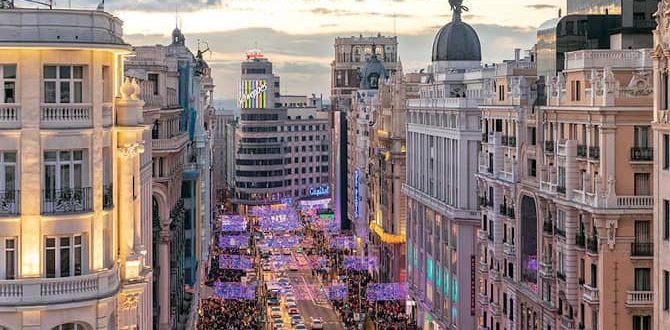
The Creation of Gran Via – An Impulse Towards Modernity
The creation of Gran Vía – A definitive advance for the consolidation of Madrid as a modern, cosmopolitan, open capital prepared for the glamor of the early 20th century.
In the first third of the 20th century, there was an important action to transform the urban center of Madrid, with the project of opening a large avenue: the creation of Gran Vía. This corridor would connect Salamanca and Argüelles quarters and would entail a social and urban reorganization of the area.
Already in 1862 the city hall addressed the possibility of building a large avenue that would cross the old town, but the project was not successful. It would be in 1886, during the Restoration, when Carlos María de Velasco’s project would prosper, becoming the antecedent of the future great avenue.
The eventual plan was approved in 1904, with Calle Alcalá and Plaza de España as starting and ending points, divided into three different sections corresponding to Calle Alcalá-Red de San Luis, Red de San Luis-Callao and Callao-Plaza de España. Due to the magnitude of the demolition and construction works, the process was also divided into three phases corresponding to the three sections of the avenue, that would go between 1910 and 1931.
Buildings of various styles were built for the creation of Gran Vía, representing the different architectural trends of the 20th century. The first section, then Avenida del Conde de Peñalver, had a commercial use and its buildings would result in an eclectic mix between academicism and regionalism, with the most representative examples being Gran Peña, el Círculo Mercantil y el Casino del Ejército y la Armada. Also la Casa del Cura de la Iglesia de San José, as an example of the influence of baroque style. And it is also important mentioning a french-style beautiful building that, although officially belongs to Alcalá street, is one of the symbols of this part of Gran Vía: the Metropolis building.

The second section, Avenida de Pi y Margall, immediately became an important set for shows and leisure, with a clear influence of American skyscrapers. One of the emblematic buildings in this part was the Madrid-Paris, the tallest in the city until the inauguration of the Telefónica building a few years later. Apart from the Telefónica Building (the tallest building on Gran Vía, 82 meters high), other unique buildings in this part would be el Palacio de la Música and a series of hotels such as the Florida, Atlántico, Alfonso XIII or Gran Vía, built in the likeness of those that were built in the main capital cities around the world.

The third section of the creation of Gran Vía, Avenida de Eduardo Dato, followed the style of the second with a number of entertainment venues, but this woud for sure be the liveliest of the three. One of the most striking buildings was the iconic Carrión (or Capitol), in an expressionist and art deco style, today in Plaza de Callao with its iconic illuminated Schweppes sign on the façade. Palacio de la Prensa was also significant; the Callao Cinema and the Rialto and Actualidades cinemas.

And not only a variety of styles, but also a variety of names through the history of the Avenue: CNT Avenue, Russia Avenue, Soviet Union or Mexico Avenue in the 1930s; during the Civil War it became known as the “Howitzers Avenue” or “Fifteen and a Half Avenue” (because of the caliber of the projectiles that were launched on it); with the dictatorship it was renamed Avenida de José Antonio (Primo de Rivera), and it would not be until democracy times, when it was definitively called Gran Vía.
What is clear is that thanks to the creation of Gran Vía, following the example of other modern big cities, we opened a cosmopolitan walk in the center of our city with commercial, administrative and entertainment buildings of various styles. Today is one of the symbols of the city, a benchmark in the world of entertainment in our country and a reflection of the lively Madrid way of life, an avenue that never sleeps!
Remember that if you want to continue discovering much more history, curiosities and places to visit in Madrid such as Gran Via Avenue, you can join one of our Free Tour Madrid in Madrid from Monday to Sunday. We hope to see you soon!